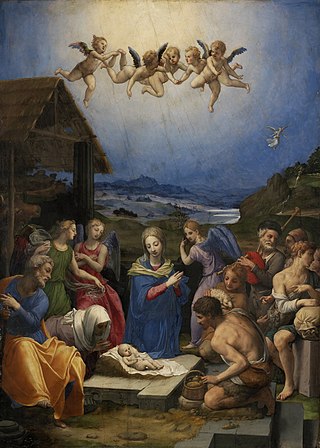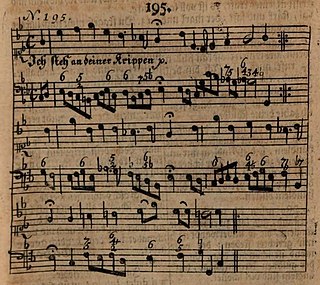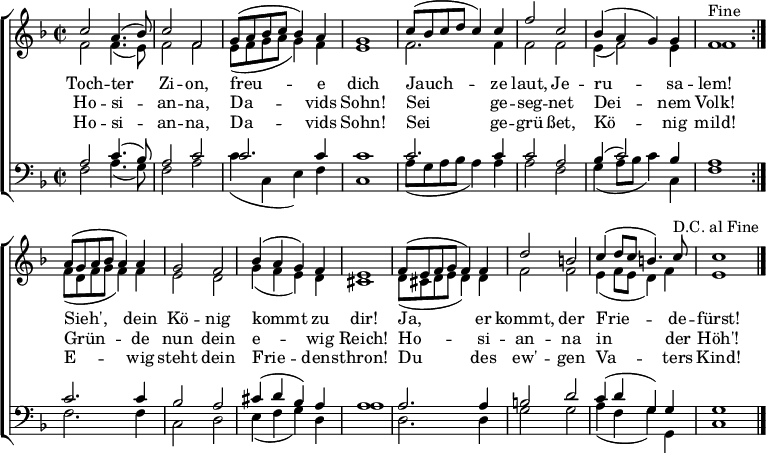
"Hark! The Herald Angels Sing" is an English Christmas carol that first appeared in 1739 in the collection Hymns and Sacred Poems. The carol, based on Luke 2:14, tells of an angelic chorus singing praises to God. As it is known in the modern era, it features lyrical contributions from Charles Wesley and George Whitefield, two of the founding ministers of Methodism, with music adapted from "Vaterland, in deinen Gauen" of Felix Mendelssohn's cantata Festgesang.

Judas Maccabaeus is an oratorio in three acts composed in 1746 by George Frideric Handel based on a libretto written by Thomas Morell. The oratorio was devised as a compliment to the victorious Prince William Augustus, Duke of Cumberland upon his return from the Battle of Culloden. Other catalogues of Handel's music have referred to the work as HG xxii; and HHA 1/24.

"Zion's Daughter" is a 1982 Christmas single by German band Boney M., the second single to be released off their Christmas Album, released in November 1981. It was a re-worked up-tempo version of See, the conqu'ring hero comes!, a chorus from Georg Friedrich Händel's 1746 oratorio Judas Maccabaeus with English lyrics by Fred Jay. The tune is also used for the German advent hymn Tochter Zion, freue dich and the English hymn Thine Be the Glory, and is well known in England as part of Henry Wood's Fantasia on British Sea Songs (1905), performed every year at the BBC's Last Night of the Proms concert.

"Thine Be the Glory, Risen Conquering Son", also titled "Thine Is the Glory", is a Christian hymn for Easter, written by the Swiss Protestant minister, Edmond Budry (1854–1932), and set to the tune of the chorus "See, the Conqu'ring hero comes" from the third section of Handel's oratorio Judas Maccabaeus. The hymn is sometimes sung at weddings or funerals.

"Gott sei gelobet und gebenedeiet" is a Lutheran hymn of 1524 with words written by Martin Luther who used an older first stanza and melody. It is a song of thanks after communion. Luther's version in three stanzas was printed in the Erfurt Enchiridion of 1524 and in Johann Walter's choral hymnal Eyn geystlich Gesangk Buchleyn the same year. Today, the song appears in German hymnals, including both the Protestant Evangelisches Gesangbuch, and in a different version in the Catholic Gotteslob.

Friedrich Heinrich Ranke was a German Protestant theologian. He was the brother of historian Leopold von Ranke (1795–1886) and the father of pediatrician Heinrich von Ranke (1830-1909) and anthropologist Johannes Ranke (1836-1916).

Georg Weissel was a German Lutheran minister and hymn writer.
Advent songs are songs and hymns intended for Advent, the four weeks of preparation for Christmas. Topics of the time of expectation are the hope for a Messiah, prophecies, and the symbolism of light, among others. Several of the songs are part of hymnals such as the German Catholic Gotteslob (GL) and the Protestant Evangelisches Gesangbuch (EG).

"In dich hab ich gehoffet, Herr" is a Lutheran hymn in seven stanzas, written by Adam Reusner and first published in 1533. He paraphrased the beginning of Psalm 31. It was first sung to the melody of a Passion hymn. The melody connected with the hymn in 1560 was derived from models dating back to the 14th century. A third melody from 1608 became a hymn tune for several other songs and translations to English. In the German Protestant hymnal Evangelisches Gesangbuch, the hymn appears as EG 257 with the second melody. Johann Sebastian Bach used the second and third melodies in chorale preludes, and the third also in cantatas and the St Matthew Passion.

"Fröhlich soll mein Herze springen" is a Christian Christmas hymn by Paul Gerhardt, originally in 15 stanzas in artful metre. It was first published, "Frölich sol mein hertze springen", in 1653 in the fifth edition of the hymnal Praxis Pietatis Melica by Johann Crüger, who also created a melody. Johann Sebastian Bach used it as a chorale in his Christmas Oratorio, with a different melody by Johann Georg Ebeling. The song is part, with twelve stanzas, of the current Protestant hymnal Evangelisches Gesangbuch and other songbooks.
"Ermuntre dich, mein schwacher Geist" is a German Christmas carol with lyrics by Johann Rist and a melody by Johann Schop, first published in 1641. Historically it was contained in Protestant hymnals, but the current one, Evangelisches Gesangbuch, uses only three of its stanzas, the ninth, the second and the twelfth, titled "Brich an, du schönes Morgenlicht". This stanza was used by Johann Sebastian Bach as a chorale in Part II of his 1734 Christmas Oratorio.

"Ich steh an deiner Krippen hier" is a German Christmas hymn, with lyrics by Paul Gerhardt which were first published in 1653. It was then sung with an older melody by Martin Luther, but a melody which was likely created by Johann Sebastian Bach for Schemellis Gesangbuch of 1736 is now part of current Protestant and Catholic hymnals.
"Nun freue dich, du Christenheit" is a Catholic hymn for Easter. It goes back to a 1390 hymn, which later appeared as "Freu dich, du werte Christenheit". The final version appeared first in the Catholic hymnal Gotteslob of 1975, later in several regional sections of the Gotteslob.
"Mein ganzes Herz erhebet dich" is the beginning of German hymns to a melody from the 16th century, which paraphrase Psalm 138. They are part of Protestant and Catholic hymnals.

"Dein Lob, Herr, ruft der Himmel aus" is a German Catholic hymn. Adolf Lohmann adapted a 1659 hymn by the Jesuit astronomer Albert Curtz, who paraphrased Psalm 19. The melody appeared in Augsburg in 1669. It was No. 1 in the 1938 hymnal Kirchenlied and is part of the German Catholic hymnal Gotteslob as GL 381.

"Liebster Jesu, wir sind hier" is a Lutheran hymn with text written by Tobias Clausnitzer in 1663, and a hymn tune, Zahn No. 3498b, based on a 1664 melody by Johann Rudolph Ahle. A prayer for illumination, it is suitable for the opening of a church service and to be sung before a sermon. The song is part of the Protestant hymnal Evangelisches Gesangbuch as EG 161. It is also part of the Catholic hymnal Gotteslob as GL 149. It is popular also in English translations such as "Blessed Jesus, at your word" by Catherine Winkworth.

"O Jesu Christe, wahres Licht" is a Lutheran hymn by the German Baroque poet, Lutheran minister and hymn-writer Johann Heermann. The text was first published in 1630 during the Thirty Years' War. It is a prayer for enlightenment of those who are ignorant, and of those who turned away. It was associated with a melody from Nürnberg, dating to 1676. The hymn is part of modern German hymnals, both Protestant and Catholic. It was translated to English as "O Christ, our true and only light".
"Herr, mach uns stark" is a Christian hymn in German with text by Anna Martina Gottschick written in 1972. The hymn for the end of the church year is sung to the melody "Sine Nomine" by Ralph Vaughan Williams. It is contained in the Catholic hymnal Gotteslob, concluded with an added sixth stanza by Jürgen Henkys. The first line is "Herr, mach uns stark im Mut, der dich bekennt".
"Komm, Herr, segne uns" is a Christian hymn in German in four stanzas with text and music by the Protestant pastor Dieter Trautwein, written in 1978. It is a hymn of the genre Neues Geistliches Lied (NGL), appearing in German hymnals of different denominations, including the Protestant Evangelisches Gesangbuch and the Catholic Gotteslob. It begins with the line "Komm Herr, segne uns, dass wir uns nicht trennen".
"Ich lobe meinen Gott von ganzem Herzen" is a Christian hymn in German, with a first stanza by Gitta Leuschner, written in 1980, and two more stanzas that Günter Balders added in 2002. The text is based on Psalm 9. The original song came from France and was a rather close paraphrase of the psalm, to a melody composed by Claude Fraysse in 1976. The song of the genre Neues Geistliches Lied (NGL) has appeared in the German Protestant and Catholic hymnals and songbooks, especially collections for children.
















